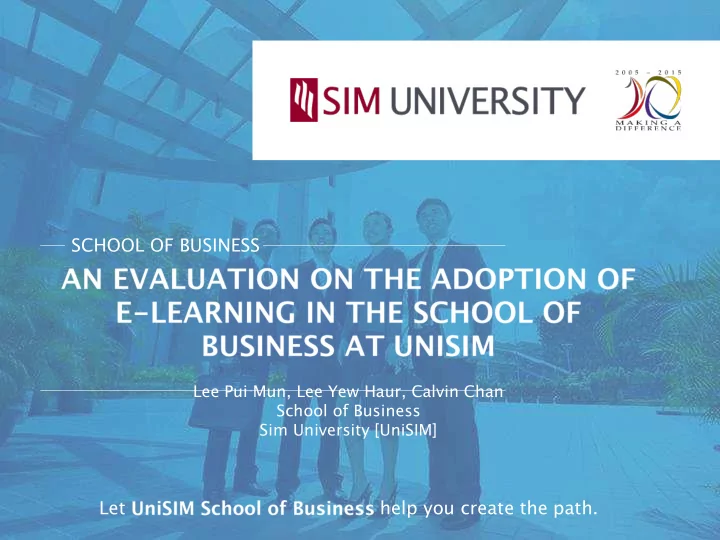

SCHOOL OF BUSINESS Lee Pui Mun, Lee Yew Haur, Calvin Chan School of Business Sim University [UniSIM] Let help you create the path.
The Context Understanding: • UniSIM Mission: To create excellence in lifelong education through a uniquely-designed learning experience, equipping learners for a better future • UniSIM’s student profile is predominantly working adults and thus commuting students • Anytime, Anywhere • Preparing for tomorrow’s workplace
Our E-learning Journey 50% of our School’s courses have been converted to e- courses. Focus on Journey has not Flipped- ended and is classroom continuing …. pedagogy Embark on Blended Learning Convert course content to E- learning mode 2015 & Beyond 2011 2013 2008
Phase 1: : Approach to E-Learning Objectives: • Support “Anytime, Anywhere” • Add value to learning • Inject multimedia into lecture materials • Digitize learning materials • Promote online interactions [graded discussions] • Promote online transactions [downloading materials/assignment submissions/completing assessments such as quizzes]
Phase 2: : Embracing Ble lended Learning Objectives: • Cut Face-to-Face Classroom sessions to half • Encourage case discussions • Introduce more formative assessments in course to promote reflection • Encourage independent learning • Align with Community of Inquiry framework
Supporting Communit ity of In Inquiry ry by y le leveraging on e-le learnin ing Holistic Education Experience : • Social Presence • Cognitive Presence • Teaching Presence Ref: Garrison and Vaughan
Phase 3: : Im Implementing Fli lipped Cla lassroom Pedagogy Objectives: • Transfer all classroom lectures to online by converting lectures into digitized “chunked lectures” • Support Independent learning [Online “discussion corners”] • Interest Corner and “ example ” • Topic Clarification Corner
Phase 3: : Im Implementing Fli lipped Classroom Pedagogy [Cont’d] Objectives: • Encourage Acquire Knowledge [ Study ] before class session and Practice Application of Knowledge during class session • Introduce “pre - class” summative quizzes • Promote interactions during f2f classes and practicing of 3 key skills: • Creative thinking • Logical in-depth analysis • Confident and responsive Communications
A pause at t Phase 3: : Evalu luatin ing St Student Perf rform rmance before and aft fter In Introductio ion of f E-le learnin ing Comparison: • Look at end-of-course assessment performance for various courses [before and after e-learning]
The e-courses UniSIM Structured Approach to E-Course Development and Qualification : • Criteria to qualify as a UniSIM e- course” • Must have chunked lectures [no more than 15 minutes per chunk] • Must have summative and formative quizzes • Courses cannot have more than half its class sessions being face2face • iStudy Guide and all student’s learning materials to be online • Submissions of assignments have to be online
Our Course Cla lassification and Strategy for e-development
E-Course Im Implementation His istory ry
Looking at “Weak” Student Performance – Before and After “e” No of semesters ECA/Exam No of % of Total No of presented No of % of Total No of (as of No of student students students after student students students latest semesters failed failed who took conversion failed failed who took Diff(N)- Course Title E-learning Eff semester) presented twice twice ECA/Exam to e-learn twice twice ECA/Exam (H) Operations Management 2012/07 WRITTEN 6 18 1.36 1328 3 28 2.43 1152 1.08 Contract and Agency Law 2014/01 ECA 14 7 0.11 6654 2 5 0.54 922 0.44 Managing Information Security and Privacy 2014/01 WRITTEN 1 0 0.00 22 2 0 0.00 78 0.00 Financial Instruments, Institutions and Markets 2013/07 ECA 13 0 0.00 3314 3 0 0.00 306 0.00 Financial Institutions 2013/07 ECA 2 0.00 101 3 0 0.00 202 0.00 Advertising and Promotions Management 2010/07 ECA 3 0 0.00 404 3 0.00 435 0.00 Economic Security and Culture 2013/07 WRITTEN 2 0 0.00 67 2 0 0.00 175 0.00 Marketing 2014/01 WRITTEN 13 86 1.92 4482 2 5 1.90 263 -0.02 Customer Relationship Management 2014/01 WRITTEN 2 2 0.52 384 2 2 0.50 399 -0.02 Marketing Mix Management 2014/01 ECA 13 2 0.04 4569 2 0 0.00 319 -0.04 Marketing Management 2013/07 WRITTEN 3 13 1.65 790 3 15 1.58 950 -0.07 Selected Topics in Management 2014/01 WRITTEN 10 5 1.40 357 2 1 1.11 90 -0.29 Selected Topics in Business Analytics 2013/07 ECA 4 1 0.54 186 2 0.00 80 -0.54 Company Law and Corporate Governance 2014/01 WRITTEN 14 99 2.17 4560 2 8 1.43 559 -0.74 Fixed Income Securities 2013/07 WRITTEN 6 12 1.97 609 2 1 1.11 90 -0.86 Government and Security 2013/07 WRITTEN 3 2 1.74 115 2 0 0.00 193 -1.74 Managing People 2014/01 WRITTEN 4 25 6.46 387 2 11 4.25 259 -2.21 IT-Enabled Business Transformation 2014/01 WRITTEN 3 42 6.11 687 2 3 0.63 476 -5.48 Corporate Finance 2013/07 WRITTEN 6 53 7.76 683 2 0 0.00 97 -7.76
Looking at Overall Student Performance – Before and After “e”
Phase 3: : Comparison Results Observations: • No significant difference in number of repeated failures before and after e-conversion • No discerning trend in % failures in courses before and after e-conversion • There was no significant difference in student feedback rating for courses before and after e-conversion [although feedback comments from some students indicate they prefer f2f, but the majority in the course did not provide such comments]
Phase 4: : Leveraging on curr rrent progress Objectives: • Able to mount full-e degree programs [no f2f contact sessions] • Reinforce culture of learning to support flipped classroom pedagogy • Change culture of teaching to support flipped classroom pedagogy
Summary ry: : Key S Success Factors to le leverage on Elearning in in Hig igher Education Top management commitment Clear directions and target Faculty Buy-in Development support Standardized criteria in developing e-learning materials Scaffolding development Cultivate Learning culture [independent learning and online discussions] Support Faculty Training to complement e-learning [flipped classroom pedagogy training] Start as a supplement to teaching and learning
Recommend
More recommend